December 30, 2016
Air Date: December 30, 2016
FULL SHOW
SEGMENTS
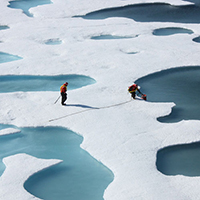
America’s Climate Denial Madhouse
View the page for this story
Although science has reached firm conclusions about the reality and dangers of human-induced climate change, many politicians and other leaders continue to live in denial of the grave threats of climate disruption to our modern way of life. In a new book, The Madhouse Effect, Penn State climate scientist Michael Mann addresses the widespread persistence of global warming denial in America with the help of cartoonist Tom Toles and discusses policy options with Living On Earth Host Steve. (10:35)
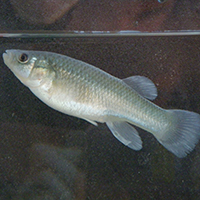
Science Note: Resilient Killifish
/ Aidan ConnellyView the page for this story
In a world of increasing pollution from humans, the Atlantic Killifish seems to have the skills to survive, and even thrive. Thanks to genetic variation, this small fish has evolved to become nearly 8,000 times more resistant to toxic environments than other fish, as Aidan Connelly reports in this week’s note on Emerging Science. (01:55)
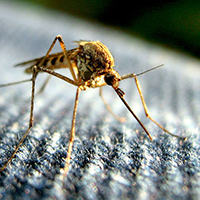
Beyond the Headlines
/ Peter DykstraView the page for this story
As we round out the final days of 2016, Peter Dykstra and host Steve Curwood look back at some of the year’s biggest environmental headlines, including environmental racism in Flint and Standing Rock, declining polar sea ice and rising global carbon dioxide levels. The boom in clean energy infrastructure across the globe suggests a possible renewable power future. Meanwhile environmental journalists have a vital responsibility to be watchdogs. (06:25)
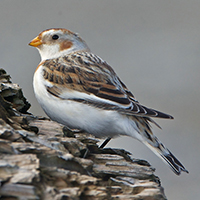
BirdNote: Winter Brings Snow Buntings
/ Mary McCannView the page for this story
These tiny brown and white-streaked birds are visual delights of winter weather, and reporter Mary McCann describes the qualities that make them feathered favorites. (01:55)
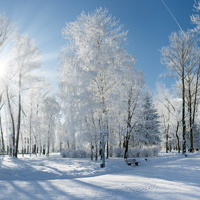
Sounds of Winter
/ Sy MontgomeryView the page for this story
Listen closely. The frigid months of winter have a sound uniquely their own. As commentator Sy Montgomery points out, the cold and gray season’s bareness and rigidity help make its sounds vibrant. (04:30)
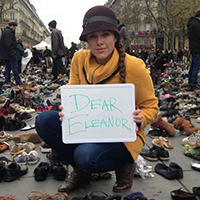
Dear Tomorrow: Letters to the Future
/ Jenni DoeringView the page for this story
Climate disruption is expected to increase over the next few decades, and climate activists Trisha Shrum and Jill Kubit looked for a way to tell their young children how they tried to make a difference. Creating literary time capsules, they wrote letters to their kids and the people of decades to come about the climate protection actions of today. They read their letters for Dear Tomorrow and talk with Living on Earth’s Jenni Doering. (09:45)
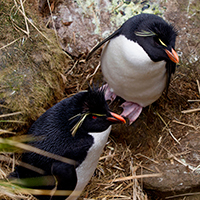
Sound of the Earth: Birds at the Southern Edge of the World
/ Mark Seth LenderView the page for this story
Rockhopper penguins and black-browed albatrosses make a racket as they share a nesting site in the Southern Ocean. Living on Earth’s Resident Explorer Mark Seth Lender recorded them at West Point in the Falkland Islands. (01:00)
Show Credits and Funders
Show Transcript
HOST: Steve Curwood
GUESTS: Michael Mann, Trisha Shrum, Jill Kubit
REPORTERS: Aidan Connelly, Peter Dykstra, Mary McCann, Sy Montgomery, Jenni Doering, Mark Seth Lender
[THEME]
CURWOOD: From Public Radio International, this is Living on Earth.
[THEME]
CURWOOD: I'm Steve Curwood. As we look back at the global warming news of the year, scientists say that political polarization makes the consensus needed for action almost impossible.
MANN: We've reached a point where people feel like they're entitled to their own facts when it comes to matters like climate change, regardless of what the scientists have to say. Increasingly, it's part
of their tribal identity, they're told, to deny climate change. If you're gonna be a good conservative you have to deny that climate change is even happening.
CURWOOD: Also, the DearTomorrow project... writing letters to the future.
SHRUM: I was thinking about my daughter, who was 10 months old, what would I say to her? How could I capture how I feel today about climate change in 2016 in a way that she can relate to when she’s my age. So I opened up my laptop and I wrote a letter to her.
CURWOOD: Those stories and more this week, on Living on Earth. Stick around.
[NEWSBREAK MUSIC: Boards Of Canada “Zoetrope” from “In A Beautiful Place Out In The Country” (Warp Records 2000)]
[THEME]
America’s Climate Denial Madhouse
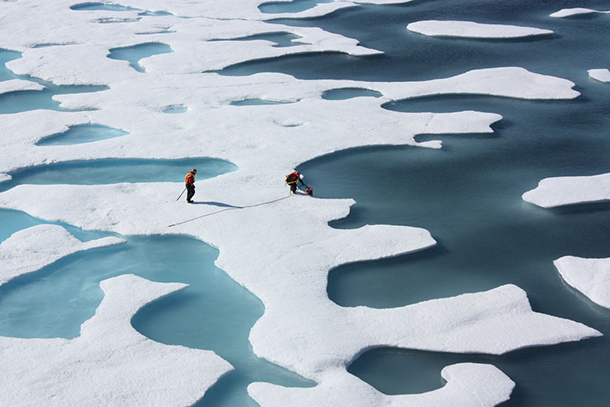
Time is running out on humanity’s chances to slow impacts on the climate, says Michael Mann (Photo: Kathryn Hansen / Nasa, Flickr CC BY 2.0)
CURWOOD: From the Jennifer and Ted Stanley Studios at the University of Massachusetts Boston and PRI, this is Living on Earth. I’m Steve Curwood. At the turn of the year, it seems appropriate to look ahead and look back, since Janus, the Roman god who faced both directions, gives us the name January. And though winter cold has settled over us in the northern hemisphere, when we look back we see that 2016 was a year of record warmth, even though those who question or deny climate science dismiss those findings. Among those trying to set the record straight is the distinguished climate scientist Michael Mann, director of the Earth System Science Center at Penn State University. He’s also the author, along with Washington Post cartoonist Tom Toles, of a recent book, “The Madhouse Effect: How Climate Change Denial Is Threatening Our Planet, Destroying Our Politics, and Driving Us Crazy”. Professor Mann, welcome back to Living on Earth.
MANN: Thanks, Steve. Always great to be with you.
CURWOOD: So here we are the end of 2016. Where are we in terms of the climate? How fast are things shifting, and what signs do we see?
MANN: Well, you know 2014 was the warmest year on record for the globe until 2015 came in, it was the warmest year on record, and now 2016 will be the new warmest year on record, and it'll beat the old record by a substantial amount. Here in the US, we've had the second warmest year thus far on record. So, when you hear climate change critics say well, global warming, it's stopped -- No, it hasn't. It's proceeding on course. The warming, if anything, is accelerated. The impacts are no longer subtle.
CURWOOD: Give me a little detail on a couple of these phenomena that you find particularly striking.
MANN: Well, in Louisiana earlier this year we saw one of these thousand-year events. What does that mean? It means that we don't expect rainfall amounts as large as what we saw there more often than once in a thousand years. And yet we've seen at least a half dozen of these thousand-year events. In the case of Louisiana, it was record rainfall associated with a system that wasn't even a tropical cyclone. Normally when you get record rainfall, it's because of a huge hurricane or tropical cyclone. In this case, the storm wasn't even a tropical cyclone, and yet it gave us enough rainfall to set new records in Louisiana - a thousand-year rainfall event. And we've seen similar things in West Virginia, Arizona, South Carolina and I could go on. The bottom line here is that the atmosphere is warmer than it was, that means it holds more moisture than it used to, that means that when conditions are conducive to rainfall you're going to get more of it.
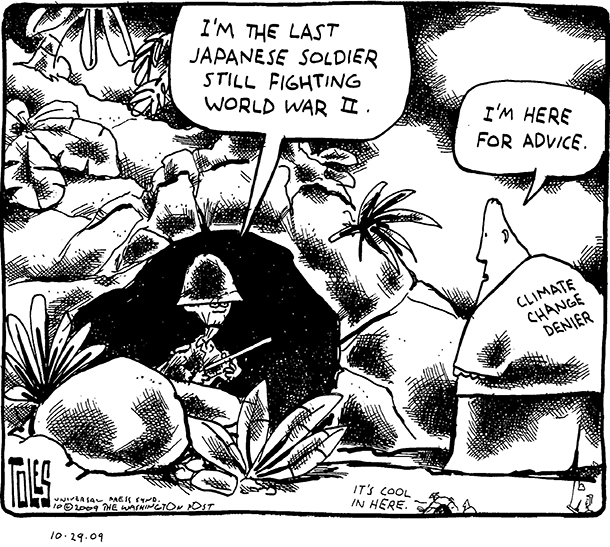
A depiction of the climate skepticism that Mann says pervades to this day. (Photo: Cartoon by Tom Toles)
CURWOOD: At one point in your new book you say time is not on our side to address the climate crisis. What do you mean?
MANN: There's a certain amount of what we call inertia to Earth's climate that's sort of like a steaming locomotive. You slam on the brakes. It's still going to go another mile down the track before it stops because it's got all this mass. It takes a while to slow down. The ocean is sort of the same way. The climate system is same way. The ocean will continue to warm for another half-century even if we slam our foot on the brakes right now, i.e., even if we were to go cold turkey on fossil fuel burning right now, and what that means is that if we are to avert catastrophic climate change and some scientists will point to two degrees Celsius, that's 3.6 Fahrenheit warming of the planet, that's sort of the level of truly dangerous irreversible changes in climate. If we don't dramatically bring down our emissions over the next decade, then we will likely commit to warming the planet more than that amount. We will commit to the worst impacts of climate change.
CURWOOD: You and I both remember Steve Schneider the scientist at Stanford University who was such a leader on climate science.
MANN: Indeed.
CURWOOD: And in a typical lecture Steve would say, "How many of you have fire insurance?" And everybody in the crowd who owned a home would typically raise their hand. And then, he'd ask the folks how many had had a fire and a few were there. On this business of the two degree limit, how are the odds of that being successful in stemming catastrophic climate change compared to, say, the risks of having a fire in one's home?
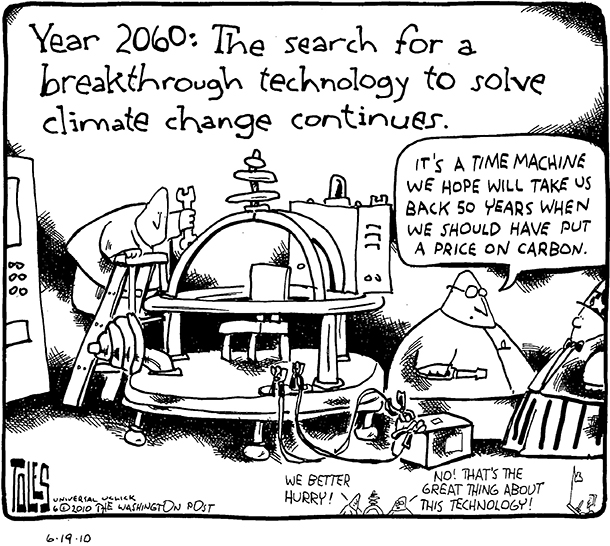
The book warns of the perils of high-tech fixes for the climate crisis. (Photo: Cartoon by Tom Toles)
MANN: Yeah, that's a great question because we buy fire insurance for our homes even though the likelihood of us encountering a fire in our home over the course of our lives is quite small - a single digit percent chance that we'll ever encounter something like that happening – and yet we pay money now every year because we know that in the event that that were to happen and we hadn't hedged against it by taking out insurance we would potentially fall victim to catastrophic impacts on our own lives. And so the irony is in the case of human-caused climate change, we're talking about likelihoods of 80, 90 percent or even higher that we will enter into a catastrophic regime if we don't dramatically bring down our carbon emissions right now. So, as you note, Steve Schneider was very effective in the way that he framed this issue as sort of a planetary insurance policy that we should be taking out right now.
CURWOOD: Specifically, Professor Mann, how does this two degree limit, how much protection does this offer us? I mean, what are the odds even if we keep it to two degrees we would have a problem?
MANN: Well, and that's another very important point because that is...that's the number that scientists have sort of settled on as when we enter into the "red zone", that is the worst impacts of climate change. But if you talk to ranchers in Texas or Oklahoma who have suffered through the worst drought on record a few years ago or people in California that are dealing with the worst drought in at least a thousand years, if you talk to the residents of New Jersey and New York City who suffered through Super Storm Sandy, if you talk to folks in Louisiana who suffered record flooding earlier this year, people who lost their homes to wildfires, if you talk to people in Bangladesh who are dealing with flooding now, the people of Miami Beach who are dealing with so-called nuisance flooding, you don't have to wait for storm now to get flooding in the streets of Miami. You just have to wait for an especially high tide because of the effects of global sea level rise. Well, for all those people, catastrophic climate change has already arrived. Climate change is already having a devastating impact on their lives, so arguably we shouldn't allow any additional warming. But there's a certain amount of additional warming that we are already committed to. It's that locomotive, it's the Titanic... turning the Titanic to avoid the iceberg. We're likely to see another half a degree Celsius, nearly a degree Fahrenheit additional warming of the planet even if we stop burning carbon right now. So we're already unfortunately committed to some pretty dangerous and damaging impacts of climate change. It is just a matter of how bad we’re willing to let them get and most scientists who've looked at the impacts, the risks, the costs have said two degrees Celsius, three-and-a-half Fahrenheit is clearly too much.
CURWOOD: In your book, you have a chapter dedicated to the perils of geoengineering. What are some of the worst-case scenarios you see as science experiments in this new field?
MANN: Yeah, the alternative title of the chapter is "Geoengineering, or What Could Possibly Go Wrong," and the principle of unintended consequences really reigns supreme when we talk about the so-called geoengineering. What we're talking about here are massive interventions with the Earth system that involve shooting things into the atmosphere, particles up into the stratosphere or dumping iron into the ocean, or putting mirrors into space to reflect sunlight or interfering with the climate system, with the global environment in some unprecedented and untested way. And a lot of the supporters of geoengineering are, I would call them, they're not climate change deniers except you could say that they're perhaps engaged in the kinder gentler form of denialism, which is not the outright denial of the science of climate change or our role in warming the planet, but, well, it won't be that bad and if we stop burning carbon it's going to hurt our economy. Well, destroying the planet will hurt our economy much more than that. When you look in detail at these schemes, in many cases they could make us much worse off than if we hadn't engaged in these interventions at all.
CURWOOD: So how much room if any do you see for perhaps a project of geoengineering used sparingly and with careful regulation?
MANN: Yeah, and I'm glad that you asked that follow up because we talk about this in the book. There are some relatively safe forms of geoengineering and the ones I've mentioned could be extremely unsafe. But there is technology that has been developed to basically create the equivalent of super trees, so plants and trees, they take carbon out of the atmosphere when they photosynthesize and they bury some of that carbon in the root systems. But a lot of that carbon that they bury near the surface in the topsoil, much of that carbon decomposes and goes back into the atmosphere. Well, what if we could create the equivalent of trees that are a million times more efficient in taking CO2 out of the atmosphere then an actual tree and they don't give the carbon back up to the atmosphere to decomposition through rotting? We capture it all and we bury it somewhere deep under the surface of the Earth where it will stay for a long time. That's relatively safe. It would be really expensive, but you know what would be more expensive? Catastrophic climate change.
CURWOOD: Many cartoons in the book. There's one that caught my eye. There are all these flames and in one corner it says “California wildfires”. Houses are lit. And then there's a hole. Well, the creature coming up through the hole who's got a long tail with a big spike at the end of it, a pitch fork and horns. And this creature says, "If this is global warming, I'll take it."
MANN: Yeah, that's right, and I believe that that creature... this was during the Bush years and there's a little bit of resemblance to the president we had at the time and I think it was a commentary on the denialism that prevailed during the last Republican administration of George W. Bush administration.
CURWOOD: Are you saying that the devil is not in the details, but in the denial?
MANN: I didn't say it, but now that you say it I would probably assent to it. I think that you could make that argument. So are our better angels. Our better angels are in, you know, all of the messengers out there who are trying to take us forwards.

The book features incisive critique of prominent climate deniers. (Photo: Cartoon by Tom Toles)
CURWOOD: Michael Mann's new book is called "The Madhouse Effect: How Climate Change Denial Is Threatening Our Planet, Destroying Our Politics, and Driving Us Crazy". We will be back in a moment.
[MUSIC: https://www.youtube.com/watch?v=QcXQcsAOx0I, Edgar Meyer with Bela Fleck, “Ziguenerweisen”]
ANNOUNCER: Support for Living on Earth comes from the Gordon and Betty Moore Foundation, and from a friend of Sailors for the Sea, working with boaters to restore ocean health.
[CUTAWAY MUSIC: https://www.youtube.com/watch?v=QcXQcsAOx0I, Edgar Meyer with Bela Fleck, “Ziguenerweisen”]
CURWOOD: It’s Living on Earth, I’m Steve Curwood. We’re back now with Penn State Professor of Atmospheric Sciences, Michael Mann. He has a new book called “The Madhouse Effect: How Climate Change Denial Is Threatening Our Planet, Destroying Our Politics, and Driving Us Crazy”. Now, famously, Professor, your emails were hacked and used by opponents of action on global warming to discredit climate science. It kind of sounds to me somewhat like the hacking during the recent election, don't you think?
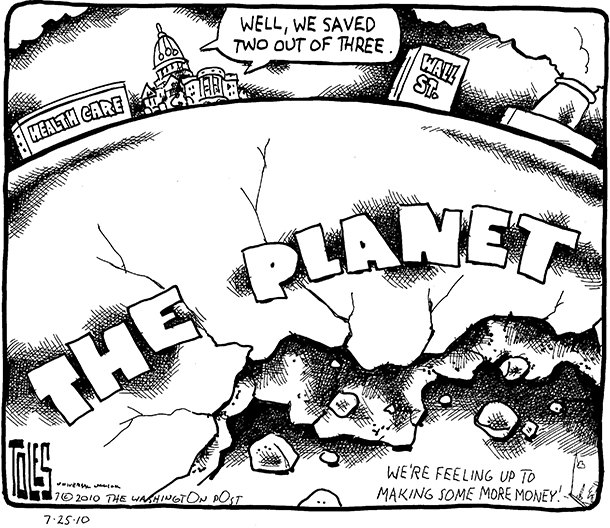
Tole’s cartoons comment on how the Obama administration dealt with climate issues. (Photo: Cartoon by Tom Toles)
MANN: Well, yeah, you know, those stolen emails -- and this was used to derail the Copenhagen Summit back in 2009 where all these emails were stolen, and words and phrases were taken out of context to try to make it sound like climate scientists were admitting that climate change is a massive hoax. It was all ridiculous. It was all a matter of just taking words and phrases out of context, misrepresenting what the scientists had to say. Now, several years later and nearly a dozen investigations later, there was no wrongdoing that was found on the part of the scientists. The only wrongdoing was the criminal theft of the emails in the first place, and it's almost eerie how closely that particular episode resembles the hacking of our recent election. We now know by Putin, by Russia, where they did exactly the same thing. They broke into servers, stole emails and misrepresented them and attempted to use the stolen material to derail, not an international climate summit, but a presidency of a potential president, Hillary Clinton, who would've been proactive on climate, who said that she would build on the progress of the Obama administration in recent years. And instead, of course, and experts say, perhaps because of the hacking of our election, we elected a climate change denier in Donald Trump, who has a very close relationship with Russia and Putin. And the argument has been made that we now have this collaborative effort to allow Russia and the US to increasingly tap into the remaining respective petroleum reserves and continue us on this course of continuing dependence on fossil fuels, continuing burning of carbon and worsening of climate change. So there are so many ways in which the two episodes were remarkably similar. It's worth noting that the stolen emails were hosted on a Russian server.

A cartoon featuring the devil that was suggested by some to resemble George W. Bush. (Photo: Cartoon by Tom Toles)
CURWOOD: And talk to me more about the war on climate science. How are things now compared to the past?
MANN: You know, there are those colleagues of mine, friends of mine, pundits, who when we published this book earlier this fall said, you know what, a book on climate change denial is sort of irrelevant today, we've moved beyond that. Little did we realize how prescient the book would seem in the context of the way things have played out in not just the UK election, the Brexit vote, but in the election of Donald J Trump. Suddenly climate change denial and delay is sort of back in style. We now encounter climate change denialism, an agenda of inaction on climate change in all of our branches of government now, in the Congress and in the presidency. It's worrying at a time when we need to be accelerating this transition away from our dependence on fossil fuels. We now have a president and a Congress who will work closely with him under Republican leadership to basically take us backwards, back towards our dependence on fossil fuels at a time when the rest of the world is moving ahead and understands that we need to get off fossil fuels.
CURWOOD: So, how would you rate President Obama's efforts, and I note that there's a cartoon in your book that shows that Mr. Obama succeeding with healthcare, succeeding with Wall Street reform, but the planet underneath is literally crumbling. Why is that cartoon there?
MANN: Yeah, I personally think that President Obama should be lauded, should be thanked for the efforts that he made to act on climate. Let's remember that he made healthcare sort of his first priority and expended a fair amount of political capital in fighting that heated battle in his first administration, and arguably didn't have the capital left to fight the climate battle. But he did recharge that capital when he won reelection and he devoted his second term really, I would argue there's no issue that he placed in higher priority than climate change in his second term. We still had a Republican Congress that not only was intransigent on climate policy, they were led by climate change deniers. So there's no way we were gonna see a Congressional climate bill. That meant that there wasn't a legislative sort of avenue to pursue when it comes to climate action, but we do have the executive branch, and he used the executive branch to pass the Clean Power Plan.
CURWOOD: Now, Professor Mann, some critics would say, well, how well did Mr. Obama really do in the face of a study that shows that the Export-Import Bank made loans and guarantees for some 75 fossil fuel plants overseas, and those plants are emitting more carbon than the reductions that are projected from the Clean Power Plan.
MANN: It's a fair point, and by no means can we say that even under his leadership that we have a perfect executive branch policy on climate. There's so much work that remains to be done. There was a limit to how much he could do, but he certainly was trying to move us in the right direction, and it depends on the metric that you use. Yes, we're exporting a lot of our carbon emissions right now. And China is doing some of that as well. They're decreasing the building of coal fired power plants domestically, but they're actually building them in other countries. So we need to take a more holistic approach to how we evaluate progress and there is a lot of work that still is left to be done. But there's still a feeling that we were headed in the right direction and that a Clinton administration would've continued on the trajectory. Now we have to deal with a very different playing field.
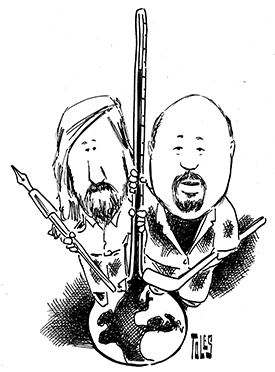
Coauthors Tom Toles (left) and Michael Mann (right) with their implements of choice. (Photo: Cartoon by Tom Toles)
CURWOOD: And in the meantime we need to stop burning fossil fuels and cutting trees, huh?
MANN: Yes, and unfortunately, our carbon emissions come from every sector of society, every aspect of our lives. So, it's our diets, it's our energy consumption, it's our transportation, it's our manufacturing. Everything we do, and because of that there is no magic bullet and that's why it's a hard problem to crack.
CURWOOD: Before you go professor, why did you create this book along with political cartoonist Tom Toles?
MANN: Well, our politics has become so contentious and we've reached a point where people feel like they're entitled to their own facts when it comes to matters like climate change, regardless of what the scientists have to say. We have this sort of deep partisanship, and there is sort of a tendency for people to trap themselves in a media bubble that reinforces their misconceptions and preconceptions. If you listen to Fox News, if you read the editorial pages of the Wall Street Journal, if you follow Breitbart News, you're convinced the climate change is a massive hoax intended to make climate scientists like myself rich. Now it sounds laughable, but there are a large number of people who believe that and increasingly it's difficult to reach them and increasingly they don't see climate change as an issue of policy or economics or environmental health. They see it as a matter of ideology. It's part of their tribal identity, they're told, to deny climate change. If you're going to be a good conservative, you have to deny climate change is even happening, and it's very difficult to reach those people. But one thing I think we have learned in recent years is that there is this amazing potential for comedy and satire to sort of reach across some of these boundaries. When you frame something in a humorous way it sort of leads to people sort of dropping their defenses a little bit, sort of finding a side door. Comedy is sort of a side door, and I believe it's why our hardest-hitting commentary today in our media comes from the Stephen Colberts and the Samantha Bees and the Bill Mahers. Comedians seem to have a certain amount of license to talk about the toughest, most contentious issues.
CURWOOD: What's funny about climate change?
MANN: Well, it's a sort of gallows humor, I suppose, at times. Tom Toles, in my view, has found a way to make delay and denial and despair funny in an odd way. But without a message of hope, without an avenue forward, gallows humor alone doesn't lead us in the right direction. And so one of the struggles in the book was to find a way to use the humor to go beyond just the exposure of hypocrisy of climate change-denying politicians, but to try to paint a positive path forward at the same time, and I hope we accomplished that. I like to think we did.
CURWOOD: So, what's the best way forward? How much of a difference can the states make in the present situation?
MANN: There's a statistic that most people aren't aware of which I consider striking, and that is even in the absence of any national climate policy because we have a Republican Congress that won't act on climate, won't put a price on carbon which is what we really need ultimately at the national level, but states are acting. I just got back from the west coast, actually had a meeting with [Governor] Jerry Brown just a few days ago who is really leading the way on this issue, and California is sort of this shining beacon at a time of darkness when we face real struggle. Jerry Brown actually said that he doesn't care what Trump does. If Trump starts to defund our climate satellites, California will build them and put them up there. California has the scientists, it has the lawyers. They're going to act. They're going to move ahead. And there's a town, the first town to ever go entirely renewable. All of its energy now comes from renewal energy. There was just a press release that I saw earlier today. Boone, North Carolina. And the Boone is Daniel Boone, and the town is named after him, and he lived in that area. Our great explorers who explored the American frontier centuries ago, well Boone North Carolina is sort of helping us move into this next frontier of getting off fossil fuel energy, and they're getting all of their energy now from renewables, and there are mayors of the largest cities, Philadelphia, Los Angeles, who are on board and acting on climate. So, I actually think along with the rest of the world which is moving ahead, we will still move forward on climate.
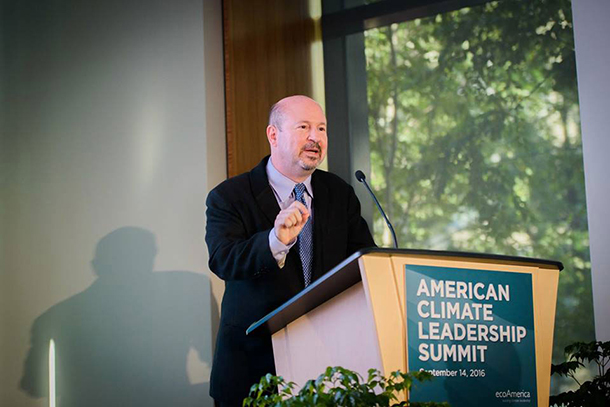
Atmospheric scientist Michael Mann directs the Penn State Earth System Science Center at Pennsylvania State University. (Photo: Courtesy of Michael Mann)
CURWOOD: Is it enough or will it be in time?
MANN: There is still a chance for us to do enough to limit the impacts of climate change to those that we can potentially adapt to. So we haven't yet committed ourselves to truly catastrophic irreversible changes in our climate that go beyond our adaptive capacity, but we don't have a lot of time left and we do need to make progress over the next few years and we're going to need to find a way to make that progress even with a US presidency which may end up on the wrong side of this issue.
CURWOOD: Penn State Professor Michael Mann's new book is called "The Madhouse Effect: How Climate Change Denial Is Threatening Our Planet, Destroying Our Politics, and Driving Us Crazy". Thanks so much, Professor, for taking the time with us today.
MANN: Thank you. It was a pleasure.
Related links:
- The Madhouse Effect – Michael Mann’s newest book
- More information on ‘Climategate’
- Washington Post: Michael Mann wins right to pursue a libel suit against critics who claimed his climate research was fraudulent.
- Michael Mann Faculty Profile
[MUSIC: https://www.youtube.com/watch?v=O7EcT5YzKhQ, Yo-Yo Ma, Edgar Meyer, Chris Thile, Stuart Duncan, “Quarter Chicken Dark,” on Goat Rodeo]
Science Note: Resilient Killifish
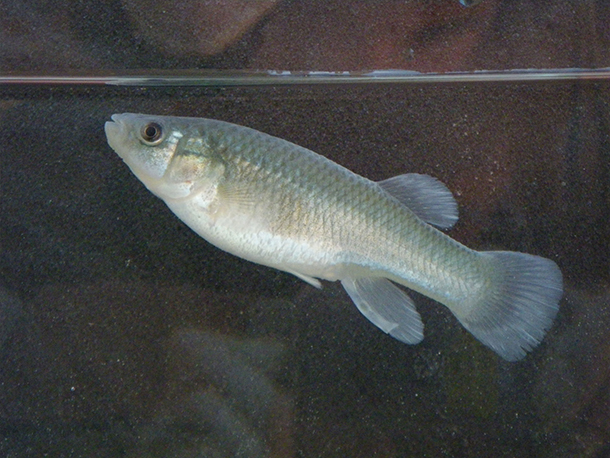
The Atlantic Killifish has a much more muted color than its vibrant siblings in South America. (Photo: Fishes of Georgia Photo Gallery, Flickr CC BY-NC-ND 2.0)
CURWOOD: In a moment, a look back at some of the headlines of 2016, but first this note on emerging science from Aidan Connelly.
[MUSIC: SCIENCE NOTE THEME]
CONNELLY: Environmental conditions have guided all evolution on earth. But ever since humans became the dominant species, we’ve extended our reach to the natural world. From domesticated dogs, to dodos driven extinct–increasingly, creatures must adapt in order to survive humans.
Case in point: the killifish. This sleek, unassuming fish is only about three inches long, and can be found throughout the Americas, from the coast of Argentina all the way up to Ontario. But in New Bedford harbor, in Massachusetts, one population of Killifish has been bathed in toxic runoff from nearby factories for decades.

Even a species as adaptable as the Atlantic Killifish can only survive human interference to a point. (Photo: Fishes of Georgia Photo Gallery, Flickr CC BY-NC-ND 2.0)
The pollution should have wiped the fish out – but instead, a study led by the University of California, Davis, shows that these Killifish, and others in similarly toxic environments along the East Coast, have thrived. The receptor in their brains that should’ve been damaged by the toxins, instead became more resilient. To get an idea of just how tough they are – scientists estimate these killifish to be 8,000 times more resistant to lethal levels of pollution than any other fish.
Researchers point to extremely high levels of genetic variation in killifish as the reason for their rapid evolution. Increased variation boosts the chances that survival genes will develop and thrive.
But while killifish have been able to adapt to pollution in their ecosystem, most animals don’t enjoy the same degree of genetic variation, and are far more vulnerable. So scientists say the task of protecting ecosystems and preserving wildlife, should fall on our shoulders – not their fins.
That’s this week’s note on emerging science. I’m Aidan Connelly.
Related links:
- Science Magazine: “The genomic landscape of rapid repeated evolutionary adaptation to toxic pollution in wild fish”
- National Geographic: “4 Clever (and Kind of Sad) Ways Animals Adapt to Humans”
- More information on Fundulus heteroclitus
[SCIENCE NOTE THEME]
Beyond the Headlines
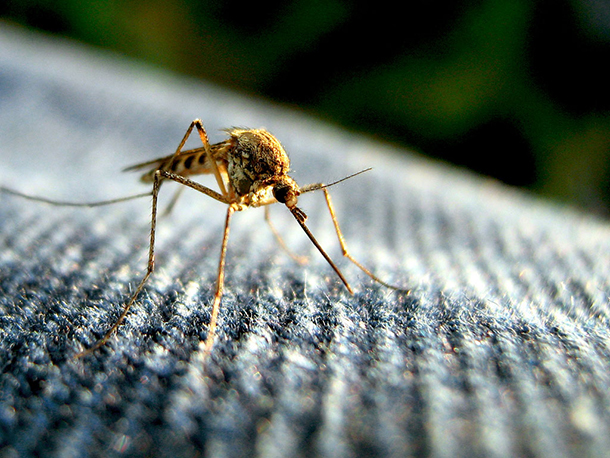
The Zika virus, which is often transmitted via mosquito, was declared a public emergency by the World Health Organization in 2016. (Photo: Tom, Flickr CC BY 2.0)
CURWOOD: Well, as 2016 winds down we turn now to Peter Dykstra for a look back at and beyond some of the biggest headlines of the year. Peter is with Environmental Health News, that’s EHN.org, and DailyClimate.org and joins us on the line from Conyers, Georgia. Hi there, Peter.
DYKSTRA: Hi Steve. You know, The Guardian put together a panel of scientists to name the top science stories of the year, and a few of them struck me in a kind of a good news/bad news sort of way.
CURWOOD: Okay well let’s get the bad news out of the way first.
DYKSTRA: At the start of the 20th Century, levels of carbon dioxide in the atmosphere were just under 300 parts per million. This year, they averaged about 400 parts per million and they’re still growing. The best scientific guesses are that about 350 ppm is the upper limit for avoiding catastrophic climate change in the future. But as for the present, 2016 saw all-time low levels of sea ice in both the Arctic and the Antarctic and month after month of record high temperatures.
CURWOOD: So what’s the good news?
DYKSTRA: Oh hang on, I’m not done with the bad news yet!
CURWOOD: I see.
DYKSTRA: The Zika virus was declared a public emergency by the World Health Organization, spreading its risks of serious birth defects to 75 countries, but out of that actually came some good news. The international community showed a strong response, partly thanks to the experience gained in battling Ebola. Zika is far from conquered or even understood, but we made some progress.
CURWOOD: So that’s the good news huh?
DYKSTRA: Definitely. It was a banner year for clean energy as well. The price for solar and wind power continued to plummet. The International Energy Agency says the world is installing more than half a million solar panels every day, and China is putting up two wind turbines every hour.
CURWOOD: Wow!
DYKSTRA: Wow indeed! In May, the entire nation of Portugal powered itself on nothing but renewables for four straight days. Texas shattered its own wind power record more than once, and on one windy Sunday late in the year, 45% of the electricity consumed in Texas came from wind. And the first offshore wind farm in the US opened for business off Rhode Island. Like wind energy, environmental justice got a lot of attention this year after being ignored for the longest time.
CURWOOD: Yeah, that’s an important issue that gets way too little attention.
DYKSTRA: But like many things dealing with race and poverty, environmental justice is often an afterthought, and heavy industry, waste dumps and refineries still disproportionately impact poor and minority communities, while places like Beverly Hills, Palm Beach or Martha’s Vineyard stay blissfully free of smelters and coal ash impoundments.
CURWOOD: Yeah, there’s no such thing as the Park Avenue wastewater treatment facility.
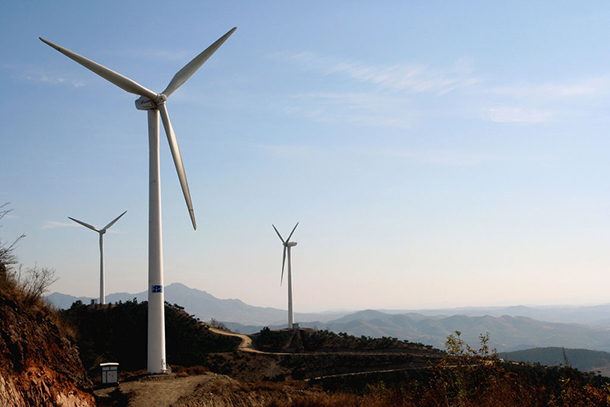
Wind turbines in the Tangshan Hills in China. (Photo: Land Rover Our Planet, Flickr CC BY-ND 2.0)
DYKSTRA: No indeed, however, this past year, two explosive stories have given new focus to environmental justice: the gross negligence of city, state, and federal officials in knowingly allowing the residents of Flint, Michigan to drink lead-contaminated water, and the resolute grass-roots opposition from Native Americans and others to the Dakota Access Pipeline that routed through sacred land and would risk the water supply of the Standing Rock Sioux reservation.
CURWOOD: Reflecting the all too typical lack of respect for Native Americans and African-Americans here in America.
DYKSTRA: Right; at least these two flagrant examples of environmental racism are getting attention. And in Flint, it was the outraged response of local citizens but at Standing Rock, it was the unprecedented coming together of Native-Americans and their supporters from every corner of the country. The national media was slow to catch on to both these stories, but eventually got the memo. At Standing Rock, it wasn’t just what the protesters did, but what was done to the protestors by law enforcement and private security forces – rubber bullets, pepper spray, fire hoses in sub-freezing weather, horses, attack dogs, and arrests -- not just of the protesters -- but even the reporters covering it all.
CURWOOD: And contrast that with the treatment of the white ranchers who staged an armed takeover of a National Wildlife Refuge in Oregon earlier in the year. The only victim was a man who resisted arrest and was said to be reaching for his weapon. And a jury refused to convict the main organizers -- Ammon and Ryan Bundy.
DYKSTRA: And I’ve got one more quick note on the lead poisoning story: in mid-December, an investigation by Reuters found nearly 3,000 US locations with lead contamination problems that are even worse than Flint.
CURWOOD: Well, bravo for Reuters, but you’ve got to ask why a news organization and not government agencies are finding such things.
DYKSTRA: And let’s have a word about government, shall we? We came into 2016 with new leadership in Canada and Australia as the last two climate-denying heads of state left standing, Stephen Harper and Tony Abbott, had been replaced. President Obama had just canceled the Keystone XL pipeline, and the world got to work implementing the landmark Paris Climate Accord. Little did we know then, that the world would swap out two medium-sized climate denying leaders for one great big one, that the Keystone XL pipeline might come back to life, and that we may not always have Paris, and even the beleaguered coal industry would be see a bit of hope.
CURWOOD: But I think just a bit. I mean it was still a lousy year for Big Coal, right? And whatever the next administration promises, surely coal’s problems are mainly due to changing economics?

President Obama sips filtered water in Flint, Michigan, after a roundtable to discuss the city’s water crisis. (Photo: Pete Souza, Wikimedia Commons, Public Domain)
DYKSTRA: Absolutely. Natural gas is cheaper and renewables are getting there. So layoffs and mine closures abounded, coal ash and abandoned mines posed growing cleanup problems, and major companies like Peabody Energy and Arch Coal fell in and out of bankruptcy, protests and local governments blocked plans for several coal export terminals, and for the first time ever, a coal baron, Don Blankenship, went to jail over mine safety issues.
CURWOOD: And we’ll see what their man who’s coming into the White House now – Mr. Trump – can do for the industry now. What do you see as some of the challenges for 2017 after this year of tremendous change?
DYKSTRA: Well, it’s pretty clear that the environment is a more divisive and partisan issue than ever. Environmental advocates need to find a way around that – it’s a daunting task given the orientation of congress and the incoming administration. Particularly since their election success is a pretty clear message that there’s not much of a political cost for showing contempt for environmental protection. On the media side, there’s some really good, strong environmental journalism out there, but it’s not taken seriously by those in charge. It’s up to editors and news executives to rise to the challenge of all the stories to be told, and, if you’ll pardon the expression, grab them by the pollution.
CURWOOD: Indeed. Peter Dykstra is with Environmental Health News.org. That’s EHN.org, and TheDailyClimate.org. Talk to you again, Peter, I guess next year.
DYKSTRA: Thanks a lot, Steve, talk to you next year.
CURWOOD: And there’s more on these stories on our website, LOE.org.
Related links:
- Bloomberg’s take on environmental news of the year
- Forbes’ look at the oil & gas situation in 2016
- Reuters: Investigative report on lead levels in US water
[MUSIC: Earl Hines, “Blue Sands,” on Tour de Force]
CURWOOD: Coming up... delighting in winter’s shaping of sound. That’s just ahead here on Living on Earth. Stay tuned.
ANNOUNCER: Funding for Living on Earth comes from you our listeners, and United Technologies - combining passion for science with engineering to create solutions designed for sustainability in the aerospace, food refrigeration and building industries. UTC companies such as Otis, Carrier, Pratt & Whitney and UTC Aerospace Systems are helping to move the world forward.
This is PRI, Public Radio International.
[CUTAWAY MUSIC: Tommy Flanagan & Hank Jones, “A Child Is Born” on Our Delights]
BirdNote: Winter Brings Snow Buntings
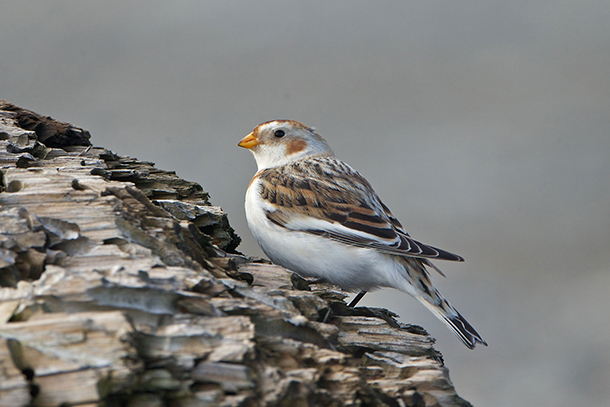
A snow bunting. (Photo: Gregg Thompson)
CURWOOD: It’s Living on Earth, I’m Steve Curwood.
[MUSIC - BIRDNOTE® THEME]
CURWOOD: As winter advances in the northern hemisphere, it’s time to bundle up and enjoy our friends and visitors, especially some rare ones, as Mary McCann observes in today’s BirdNote.
BirdNote®
Winter Brings Snow Buntings
[Sound of winter wind]
On this December morning, imagine looking outside to see plowed fields and a cloud of wind-driven snow approaching.
[Sound of winter wind]
Undulating back and forth, the small cloud finally settles to the brown earth. Now it’s clear – that rolling white cloud isn’t snow at all, but a flock of Snow Buntings. These birds bring the barren landscape to life.
[Rattling call of Snow Buntings]
Sparrow-sized, Snow Buntings begin their lives amid the harsh conditions of the high Arctic. [Snow Bunting song] And unlike nearly all other songbirds on the continent, they’re feathered in immaculate white, highlighted in winter with rich, rusty brown.
They’re prized winter visitors to the northern tier of states. Look for them along shorelines, in farmland, and open country – landscapes that mirror the Arctic tundra where they fledge their young. [Rattling call notes of Snow Buntings]
I’m Mary McCann.
###
Written by Bob Sundstrom
Sounds of the Snow Bunting provided by The Macaulay Library of Natural Sounds at the Cornell Lab of Ornithology, Ithaca, New York. Call and song recorded by Gerrit Vyn; call recorded by W.R. Evans.
Producer: John Kessler
Executive Producer: Chris Peterson
© 2010/2016 Tune In to Nature.org December 2016 Narrator: Mary McCann
[MUSIC: Pat Donohue, “December Waltz” on Profile]
CURWOOD: For pictures of these lovely visitors, flutter over to our website, LOE.org.
Related links:
- Listen on the Birdnote® Website
- More on the Snow Bunting
[MUSIC CONTINUES]
Sounds of Winter
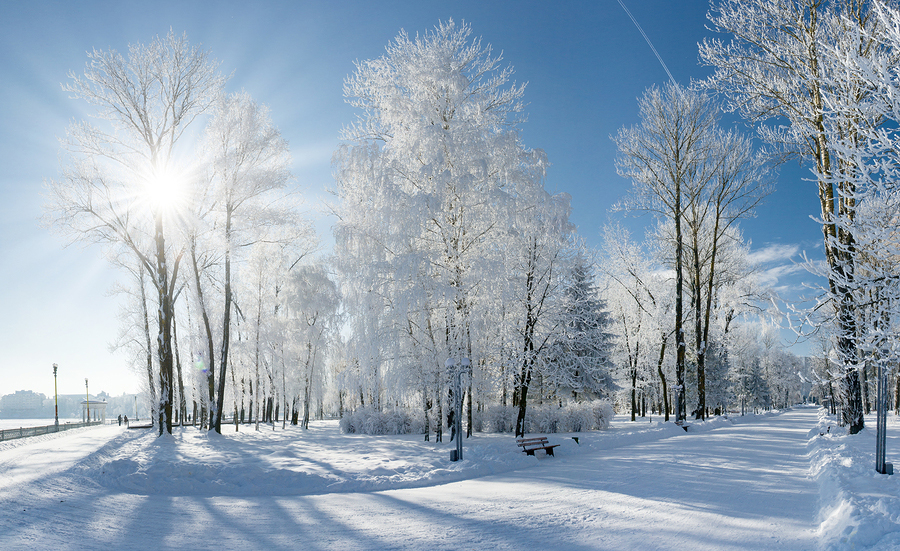
A beautiful winter landscape. (Photo: Bigstockphoto)
CURWOOD: Yes, winter birds can delight the eye, and this season can bring pleasure to some other senses as well. At least, that’s what Living on Earth commentator and New Hampshire resident Sy Montgomery thinks. She says during the short cold days in New England one should take the time to listen.
[CHICKADEE CHIRPING AND WINGS FLAPPING]
MONTGOMERY: At no other time of the year are sounds so sharp. The scolding winter call of the chickadee. Wind howling through oaks, or whispering through pines. The clarion call of wind chimes, piercing as the cold itself.
[XYLOPHONE-LIKE SCALE OF WIND CHIMES SOUNDING]
MONTGOMERY: Hearing may be the richest sense. Helen Keller wrote she felt its absence a handicap far worse than blindness. As if to make up for winter’s void – of colors muted, touch numbed, and scents sealed – winter’s sounds are the most vibrant.
[WHIZZ OF RUBBER SNOW TUBE SLOWING TO A STOP, CHILDREN LAUGHING]
MONTGOMERY: Sound travels further over frozen ground. Frozen surfaces are rock-hard, so they don't absorb sound – they reflect it. And when the atmosphere above is warmer than the ground, sound bounces back toward the ground. Winter’s freeze is like having a sound reflector in the sky.
[SCRAPING, RHYTHMIC GLIDE OF SKATES ON ICE]
MONTGOMERY: Winter’s bareness amplifies and clarifies its voices. Spring and summer are crowded with ambient noise: the sounds of birds and insects, the rustle of animals in the woods, the whisper of grasses and leaves – not to mention the hubbub of so many people and their machines.
[CREAK OF SWAYING TREE]
MONTGOMERY: In summer, leaves absorb sound, especially the higher frequencies. But now, the trees are bare, summertime’s murmurs are hushed, and snow is covered with hard ice crust. Sound slices through the air—stark, clear, pure.
[CRUNCH OF FOOTSTEPS IN SNOW]
MONTGOMERY: So this is the best time of year, I think, to go somewhere secluded – just to listen. Listen for the voice of the wind. The ancients said that Boreas, the north wind, loved a nymph who was changed into a pine tree. Boreas still rages and howls through oaks and maples and beech, but his voice is quite different when he speaks to his love.
Listen to the voices of the trees. They creak like rusty hinges as they sway in the wind. Sometimes trees will even pop loudly – it can sound like fireworks – their wood expanding and contracting during sudden changes in temperature.
Listen to the voice of the ice. On a lake, sometimes, you can hear the ice squeak, or crack, or even boom. Even safe, solid ice will make a cracking sound as it expands. Scary to an ice skater – but if you’re walking in the woods, the booming of a lake is like music.
And remember, in winter, that one of the greatest rewards of listening can be silence. Orchestras know this. At the end of a performance of Mozart’s Fantasy in C Minor, a thousand ears strain for the last note.
[PIANO MUSIC RUNNING UNDER]
MONTGOMERY: Silences are different in winter, too. This is not the soft, glowing stillness of pre-spring, or the absorbing quiet of swimming underwater. No, winter’s silence, like its sounds, is piercing, clear and cleansing, like a shooting star, well worth seeking and savoring.
[PIANO MUSIC CONTINUES AND FADES AWAY]
CURWOOD: Sy Montgomery is the author of more than a dozen books including The Good, Good Pig, The Search for the Golden Moon Bear, and The Wild Out of Your Window: Exploring Nature Near At Hand.
Related links:
- Sy Montgomery
- More about Sy Montgomery
[MUSIC: Ian Ethan “Rhyme & Reason” (The Narrow Way)]
Dear Tomorrow: Letters to the Future
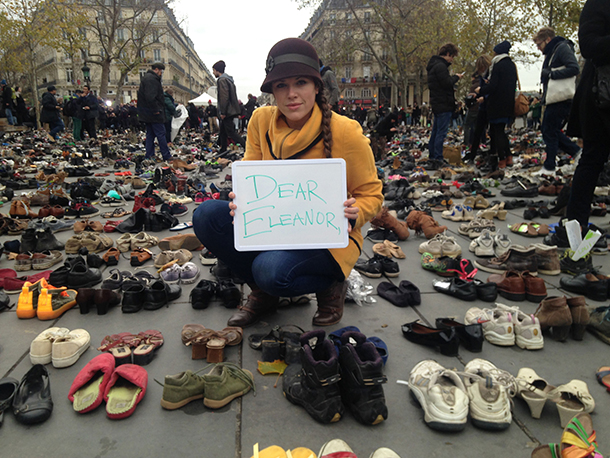
Trisha Shrum at COP21 in Paris in 2015 (Photo: DearTomorrow)
CURWOOD: As we turn into the new year, it’s a time for looking ahead to what the next 365 days might bring. Perhaps there will be a new blip in our changing climate regime. But years from now, when a child born today steps into adulthood, science tells us change will be well beyond a mere blip as we face a markedly warmer world. And while some warming is inevitable, what we do today can affect the extent, and that’s what a pair of climate activists would like us to consider. They have started a project called Dear Tomorrow that invites us to write letters to be read decades in the future about the steps we are taking now to lessen climate disruption. Trisha Shrum and Jill Kubit founded DearTomorrow and spoke with Living on Earth’s Jenni Doering.
DOERING: Trisha Shrum says the idea "For Dear Tomorrow" flew into her head in 2014, somewhere far above the Atlantic.
[JET AIRPLANE SOUNDS]
DOERING: She was flying home from a climate change conference in Iceland.
SHRUM: At the same conference, there was also Christiana Figueres, the head of the UN climate negotiations. And she gave a talk and ended with this really haunting story, that she has this dream where the eyes of these children who are living in the future are looking at her and saying, “You knew about climate change. What did you do about it?” And thinking about how that drives her and how that’s really what keeps her going and doing so many incredible things leading the climate negotiations, something kind of clicked for me.
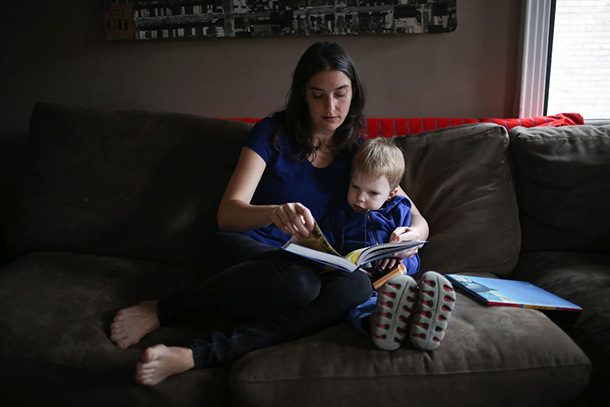
Jill Kubit reads to her son, Gabriel (Photo: DearTomorrow)
[MUSIC: “Nocturne in F Minor, Op. 55, No. 1 (Variation),” arr. Chad Lawson for piano, The Chopin Variations (Hillset Records 2014)]
SHRUM: And on the way back from that trip, I was thinking about my daughter, who was ten months old – it was the first time I’d been away from her – like, what would I say to her? What would I say to her now, and how could I capture this moment of how I feel today about climate change in 2016 in a way that she can relate to when she is my age. So I opened up my laptop and I wrote a letter to her.
[SHRUM READING LETTER FADES IN WITH TYPING SOUNDS UNDER]
Dear Eleanor,
You are not yet a year old, and I love you dearly.
[TYPING SOUNDS]
SHRUM [READING]: and the idea was that she was going to read it, I was going to send it to her, in the year 2050. I’m on a plane right now, watching the sun set for four hours as we chase it through the sky.
And I was just writing in a very honest, open way, of everything that I’ve been doing on climate change.
SHRUM [READING]: I have been driven by the climate change problem for quite a few years now.
The times I’ve struggled to feel like I was powerful enough, or that what I did really mattered enough to keep going.
SHRUM [READING]: In 2009, we all hoped that we would reach an international agreement in Copenhagen. And the negotiations failed. I became so discouraged I stopped believing it was possible to come to a global agreement on climate change.
And just realizing that all of that work and all the things that we do on climate change – suddenly, with my own daughter, it was very clear who I was working for.
SHRUM [READING]: I don’t know what the climate will look like in the year 2050. I think you’ll have a very different coastline. Many animals will be gone. The coral reefs are probably gone. The coral reefs were beautiful. Your father especially loved snorkeling. We went snorkeling on our honeymoon in Thailand and saw beautiful creatures of all colors and unlikely shapes. When you are old enough to hold on to the memory, I’ll take you snorkeling so you can see them for yourself and tell your kids about them.
And the moment that was probably the most powerful was when I was kind of almost giving my excuses as to why I hadn’t maybe gone as far or as full-in on climate change as I could have.
SHRUM [READING]: I’ve tried, but, to be honest, I haven’t tried all that hard. Instead I’ve focused on my own life. I fell in love with your father and got married and had you. Normal beautiful things. But I stopped trying so hard.
And, you know, saying like it’s so big, I’m so small, it’s so hard. And when you try to give excuses to your child about why you didn’t protect their future and why you didn’t enable the best possible world for them that you could. Those excuses just fall flat. You know, you can’t excuse yourself from your responsibility as a parent.
SHRUM [READING]: And now I am beginning to see that for you, I need to try harder than ever before.
And I started to think, you know, maybe if this is so powerful of a moment for me, if we could get other people to come in and write a letter or think about climate change from the perspective of, this is part of the legacy that I’m leaving for my kid, then that would be a way to really connect to people.
SHRUM [READING]: I love nature so much. It has been my sanctuary and my church and my playground ever since I was a little girl. And I want you to have that. I want you to have the opportunity to enjoy the beauties and the fruits of the world I knew. It is such a beautiful world. I love you dearly, my sweet daughter. You are so small. So innocent. So beautiful. For you and for everyone else, I will try harder.
All my love,
Mama

Letter-writer Ryan Wilson with his kids Seamus and Tuva (Photo: DearTomorrow)
DOERING: Trisha Shrum brought her idea to write letters to the future back to Harvard, where she was a grad student. Fellow student Jill Kubit heard about a meeting to discuss a potential project on climate change.
KUBIT: You know, I had been spending like the last eight years of my life really thinking about, you know, how do we frame climate change in a way that’s relevant for people? How do we connect to people? And I had always felt like as a movement, as organizations, and as people, we weren’t always talking about it in a way that really, really got to the core of like, why are we doing this work. And the moment I heard this idea – Trisha was like, “I wrote this letter, it was a very powerful thing for me”. I was like, “I’m on board, I’ll do anything.”
DOERING: That’s how Jill became a co-founder of DearTomorrow. At the time, her son Gabriel was eighteen months old.
KUBIT: And I had been thinking a lot about what was it going to be like raising a child in this period of time which is very scary, and also potentially very exciting.
DOERING: So she wrote her own letter to explain to her son.
[MUSIC: Nocturne in F Major, Op. 15, No. 1, Frédéric Chopin, performed by Brigitte Engerer, Chopin Nocturnes (Harmonia Mundi 1993)]
KUBIT [READING]: Dear Gabriel,
When I think about my own role in this challenge, I am reminded of one of my favorite quotes from one of last year’s DearTomorrow letters. MJ Coren so vividly wrote: “The ledge is crumbling. And those of us who stare down into the abyss wonder how will we ever get people to step back.”
I am one of the people staring down into the abyss. But with everything that I have learned about the solutions, I can also imagine that just across the way there is another ledge facing us. To me, the abyss looks more like a deep, narrow gorge, a ravine. This new ground across the way is a place where we have not been, a new world powered by renewable energy. If we can just get over to the other side, we can get onto more stable ground. We just need enough people to step back and build enough momentum to jump forward to this new place.
The DearTomorrow project is a small piece in trying to get people to take a step back, to reflect about what climate change means and to imagine what the other side looks like. This is my part of the solution. I am doing this for you.
With much love,
Mama
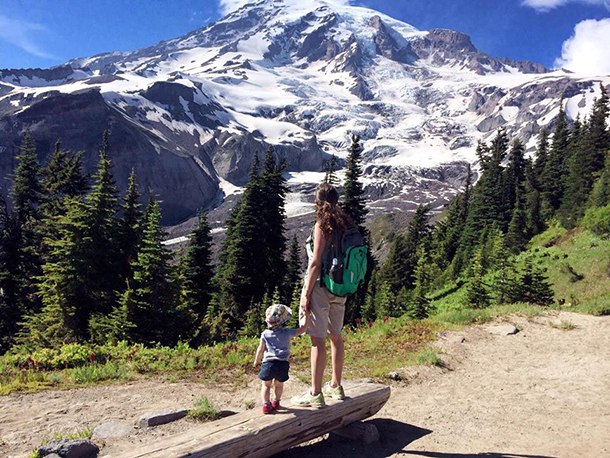
Trisha Shrum and her daughter Eleanor gaze up at the glaciers of Mount Rainier in Washington State, which are receding (Photo: DearTomorrow)
DOERING: Jill Kubit’s son Gabriel is still just a toddler and won’t be able to read that letter for several years. But Jill and Trisha have posted many of the letters they've gathered on the DearTomorrow.org website – where, they hope, they may help spur some action. Here's Trisha.
SHRUM: What we really want is to reach those people who are – they’re not climate deniers – that’s not really our focus. They’re kind of the people in the middle, regular people who think climate change is important, but they don’t necessarily see that it’s connected to their daily lives. And it’s important, but it’s not their highest priority. And we think that for those people, and especially for those people who have young children, those are the people that we can really reach with this project.
KUBIT: I also think that there’s a role for people who are already engaged in the climate movement to share their stories. At the heart of it, this is a storytelling project. And there’s people out there who have been impacted by climate change, or pollution, or polluted water. There’s also lots of stories of people who are creating new businesses, people who have risked being arrested, people who are talking to their representatives and are really really passionate about this issue and there are people out there who already connect this issue to their core values of their families. And so we want to give people a space to share their stories. And then, use it as a place where they can talk to their friends and family about why they care so much about this issue.
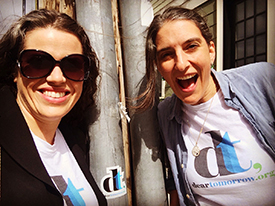
Trisha Shrum, left, and Jill Kubit are looking for an institution to house DearTomorrow’s letters in perpetuity (Photo: DearTomorrow)
DOERING: Jill Kubit. She says they plan to collect the letters written to the people of tomorrow, for a very long time, so Trisha Shrum says they're looking for a safe place to keep them:
SHRUM: We want an institution that can archive these letters so they’re gonna be available when our kids are grown, but also when we are long-gone dust in the wind and that this is a historical archive for generations to come. And then in 2030 and 2050, and potentially beyond, we want to set up a public exhibition of these letters.
CURWOOD: That’s DearTomorrow co-founder, Trisha Shrum along with Jill Kubit. She spoke with Living on Earth’s Jenni Doering.
Related link:
The DearTomorrow website
[MUSIC: Joshua Messick, “What a Wonderful World”]
Sound of the Earth: Birds at the Southern Edge of the World
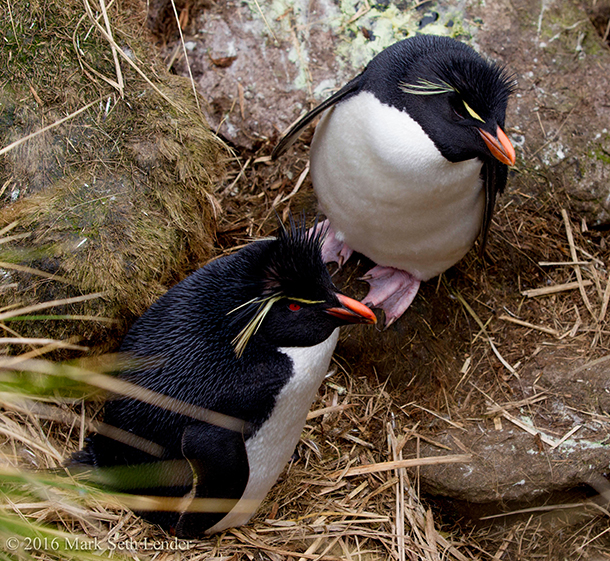
Rockhopper penguins in a nest (Photo: Mark Seth Lender)
[CALLS OF BLACK-BROWED ALBATROSSES AND ROCKHOPPER PENGUINS]
CURWOOD: We leave you this week – in the vast mostly empty Southern Ocean…
[CALLS OF ALBATROSSES AND ROCKHOPPER PENGUINS]
CURWOOD: Though the roaring 40s and furious 50s are among the least populated places on the planet – the steep cliffs of West Point on the Falkland Islands, house a huge crowded rookery ….
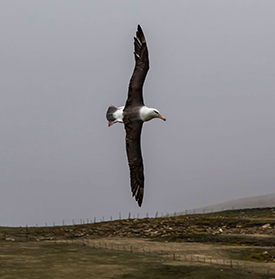
Black browed albatross in flight (Photo: Mark Seth Lender)
[MORE CALLS OF ALBATROSSES AND ROCKHOPPER PENGUINS]
CURWOOD: It’s the black-browed Albatross that’s laughing - and the high-pitched squawking comes from Rockhopper Penguins.
[MORE CALLS OF ALBATROSSES AND ROCKHOPPER PENGUINS]
CURWOOD: Both these species are awkward and ungainly on land – but masters of the wild waves that surround them.
[MORE CALLS OF ALBATROSSES AND ROCKHOPPER PENGUINS]
CURWOOD: Living on Earth’s Explorer in residence, Mark Seth Lender recorded these obstreperous birds – and took the photos you can see at our website, LOE.org.
Related link:
Find more photography on Mark Seth Lender’s website
[MUSIC: Joshua Messick, “Bach Cello Suite”]
CURWOOD: Living on Earth is produced by the World Media Foundation. Our crew includes Naomi Arenberg, Bobby Bascomb, Savannah Christiansen, Jenni Doering, Jaime Kaiser, Don Lyman, Alex Metzger, Helen Palmer, Adelaide Chen, and Jolanda Omari. And we bid farewell to intern Aidan Connelly this week. Aidan, thanks for all your cheerful hard work and inspiration and good luck. Tom Tiger engineered our show, with help from Jeff Wade, Jake Rego and Noel Flatt. Alison Lirish Dean composed our themes. You can hear us anytime at LOE.org, and like us, please, on our Facebook page - PRI’s Living on Earth. And we tweet from @LivingOnEarth. I'm Steve Curwood. Thanks for listening.
ANNOUNCER1: Funding for Living on Earth comes you, our listeners, and from the University of Massachusetts, Boston, in association with its School for the Environment, developing the next generation of environmental leaders. And from the Grantham Foundation for the protection of the environment, supporting strategic communications and collaboration in solving the world’s most pressing environmental problems. Support also comes from the Energy Foundation, serving the public interest by helping to build a strong, clean, energy economy, from Gilman Ordway, and from SolarCity, America’s solar power provider. SolarCity is dedicated to revolutionizing the way energy is delivered by giving customers a renewable alternative to fossil fuels. Information at 888-997-1703. That’s 888-997-1703.
ANNOUNCER2: PRI. Public Radio International.
Living on Earth wants to hear from you!
Living on Earth
62 Calef Highway, Suite 212
Lee, NH 03861
Telephone: 617-287-4121
E-mail: comments@loe.org
Newsletter [Click here]
Donate to Living on Earth!
Living on Earth is an independent media program and relies entirely on contributions from listeners and institutions supporting public service. Please donate now to preserve an independent environmental voice.
NewsletterLiving on Earth offers a weekly delivery of the show's rundown to your mailbox. Sign up for our newsletter today!
 Sailors For The Sea: Be the change you want to sea.
Sailors For The Sea: Be the change you want to sea.
 The Grantham Foundation for the Protection of the Environment: Committed to protecting and improving the health of the global environment.
The Grantham Foundation for the Protection of the Environment: Committed to protecting and improving the health of the global environment.
 Contribute to Living on Earth and receive, as our gift to you, an archival print of one of Mark Seth Lender's extraordinary wildlife photographs. Follow the link to see Mark's current collection of photographs.
Contribute to Living on Earth and receive, as our gift to you, an archival print of one of Mark Seth Lender's extraordinary wildlife photographs. Follow the link to see Mark's current collection of photographs.
 Buy a signed copy of Mark Seth Lender's book Smeagull the Seagull & support Living on Earth
Buy a signed copy of Mark Seth Lender's book Smeagull the Seagull & support Living on Earth

